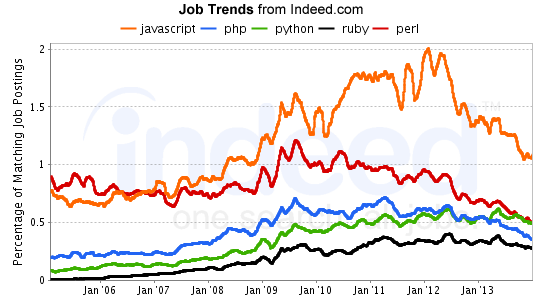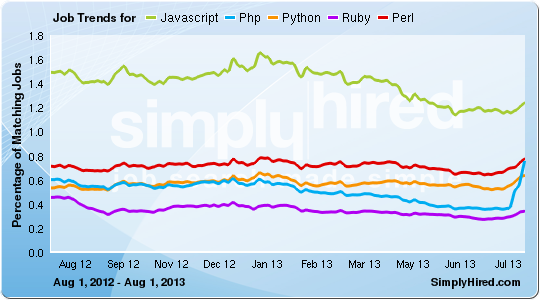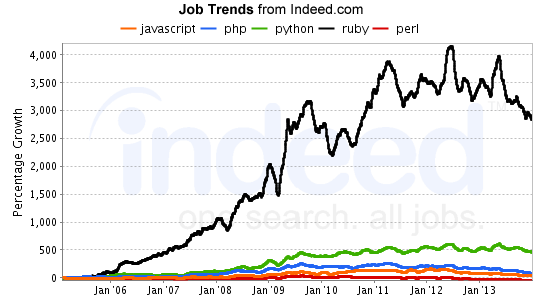Programming Language Job Trends Part 2 – February 2014
In part 1 of the programming language job trends, we looked at Java, C++, C#, Objective C, and Visual Basic. In today’s installment, we review the trends for PHP, Python, JavaScript, Ruby, and PERL. Watch for part 3 in the next few days, where we will look at Erlang, Groovy, Scala, Lisp, and Clojure.
First, let’s look at the trends from Indeed.com:

As you can see, there has been a general downward trend for all of these languages in 2013. This is fairly consistent with the trends seen in part 1 of the language trends. The really surprising part of this is the 50% decrease in JavaScript demand in the past two years. This is a much higher rate of decline than the others. Perl is in steady decline, now running on 4 years. PHP’s decline is much more recent, really only appearing in the last year. Python and Ruby, while showing a slight decline in the past 6 months, are the most stable. We can likely attribute this to their overall rise in popularity in both startup and enterprise software shops.
Now onto the short-term trends from SimplyHired.com:
Given that SimplyHired’s data is about 6 months old, it is difficult to compare to Indeed. However, only JavaScript is showing a real decline during 2013 with a slight uptick during July 2013. PHP shows a huge jump during July, almost a 100% increase, which is abnormal for these trends. I am guessing we are dealing with bad data for this even if there is a decent increase. The other trends all show a small increase during July, which is at least somewhat reassuring.
Lastly, we look at the relative growth trends from Indeed.com. This compares percentage growth as opposed to percentage of all postings:
Given that overall percentage of jobs could be a misleading metric, the relative growth shows a different perspective. Ruby demand has obviously been increasing at a rapid rate, however that growth seems to have slowed a bit in 2013. Python shows solid growth, hovering at 500% since the middle of 2010. While you can’t really see accurate trends for the others, you can review the graph without Ruby. Perl is actually showing a purely negative trend for about 18 months. Javascript growth has slowed to about 50%, while PHP has dipped below 100%.
Overall, the demand is similar to the first part of the job trends posts, a slight decline in demand everywhere. The growth trends for these languages are not great either with the exception of Ruby. Given that Ruby and Python are still growing significantly, and based on the buzz on blogs, my guess is that these two languages are really starting to make inroads into the enterprise which has typically been the home of Java and C#. Stay tuned for part 3 where we look at some younger languages, and one oldie that seems to never go away.







